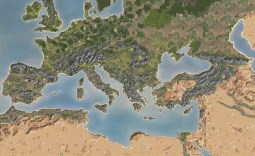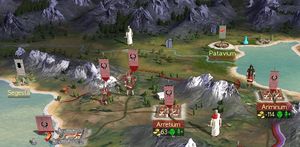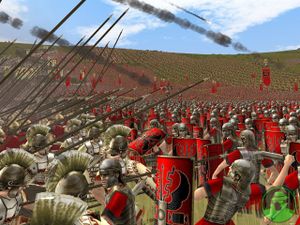Difference between revisions of "Rome: Total War"
m (Most images seem long gone) |
(removed large screenshots section as suggested - attempted to use last one as thumbnail) |
||
| Line 7: | Line 7: | ||
===Campaign Play=== | ===Campaign Play=== | ||
| − | [[Image:Radar_map1.jpg|thumb|right|A radar map of the Imperial Campaign's map]][[Image:RTW campaign map.jpg|thumb|right|Screenshot of RTW's main campaign map]] | + | [[Image:Radar_map1.jpg|thumb|right|A radar map of the Imperial Campaign's map]][[Image:RTW campaign map.jpg|thumb|right|Screenshot of RTW's main campaign map]][[File:RTW-battle-screenshot.jpg|thumb|right|Screenshot of large battle in RTW]] |
The Imperial Campaign starts in 270 BC and ends in 14 AD. Each year consists of two turns. The player controls one of the playable factions on the campaign map with the goal of conquering new regions in order to achieve victory. They can build various structures, expand their cities and move around characters. When the armies of two factions meet each other, they will engage in battle. The player can choose between auto-resolving the battle and fighting it themselves on the 3D battle map. | The Imperial Campaign starts in 270 BC and ends in 14 AD. Each year consists of two turns. The player controls one of the playable factions on the campaign map with the goal of conquering new regions in order to achieve victory. They can build various structures, expand their cities and move around characters. When the armies of two factions meet each other, they will engage in battle. The player can choose between auto-resolving the battle and fighting it themselves on the 3D battle map. | ||
| Line 30: | Line 30: | ||
:''*See [[Battle Map Play - RTW]] for elements specific to Rome: Total War. | :''*See [[Battle Map Play - RTW]] for elements specific to Rome: Total War. | ||
| − | |||
| − | |||
| − | |||
| − | |||
| − | |||
| − | |||
| − | |||
| − | |||
| − | |||
==Historic Accuracy== | ==Historic Accuracy== | ||
Revision as of 12:18, 12 August 2018

|
This article needs some additions or rewriting. Please discuss this issue on the talk page, or contact Wiki Staff. Please remove this tag when the page has been improved. |
| Total War Series |
|---|
|
Total War: Three Kingdoms - Portal Total War Saga: Thrones of Britannia Medieval II: Total War - Portal |
Rome: Total War (sometimes abbreviated as RTW) is a strategy game in the Total War Series which combines a turn-based campaign map with real time battles. The game was developed by the Creative Assembly and was released on September 22, 2004.
Contents
Gameplay
Campaign Play
The Imperial Campaign starts in 270 BC and ends in 14 AD. Each year consists of two turns. The player controls one of the playable factions on the campaign map with the goal of conquering new regions in order to achieve victory. They can build various structures, expand their cities and move around characters. When the armies of two factions meet each other, they will engage in battle. The player can choose between auto-resolving the battle and fighting it themselves on the 3D battle map.
The Campaign Map
Rome: Total War's Imperial Campaign map includes Europe, the Mediterranean Sea, parts of North Africa and the Middle East. The campaign map offers many different features. Along with various locations such as settlements and ports there are also several different campaign map characters. Amongst those are generals, captains, diplomats, spies and assassins. The settlements and characters are controlled by the different factions which fight against each other in order to achieve supremacy. Each faction can only see areas which its characters have scouted and regions which are out of sight are covered by the Fog of War, though new information may be negotiated from other factions through diplomacy. Movement around the campaign map is different from earlier games, giving characters more detailed movement than the previous "Risk-style" system.
Factions
- *See main article: Factions (RTW)
Initial play is restricted to the three playable Roman factions, the Julii, Scipii and Brutii with other factions becoming accessible after successful completion of a campaign. The three playable Roman factions are allied to each other and the Senate. The Senate issues missions to each of the Roman factions, successful completion of Senate missions improves your family's standing with the Senate, while military successes and expansion increase your prestige in the eyes of the masses. A high popularity level is necessary to be able to initiate a civil war against one of the other Roman factions.
Other factions designed to be played after successful completion of your first campaign are: Egypt, Seleucid Empire, Carthage, Parthia, Gaul, Germania , Britannia and the Greek Cities.
Units
Rome: Total War units include a vast range of different infantry, cavalry and artillery.
Battle Play
Battles in Rome: Total War can be epic events containing thousands of individual soldiers.
- *See Battle Map Play - RTW for elements specific to Rome: Total War.
Historic Accuracy
Various criticisms have been levelled at the game in regards to historical inaccuracies. The splitting of Roman territory into that of the Senate and then those of three families is somewhat ahistorical, as is the simplification of Roman politics, a mechanism which has been removed from many mods of the game in order to introduce a greater variety of factions. The treatment of the Greek Cities as one unified body, governed from Sparta, as well as the arming of hoplite units with long pikes, makes the Greeks a rather inaccurately represented faction. Other inaccuracies include the large and unified territories of many barbarian tribes, much like the Greeks, and the fielding of Bronze Age Egyptian troops rather than those of the Ptolemaic era.
Main Differences to Earlier Total War Games
A major difference between Rome and earlier games in the Total War Series is the way the in campaign battle maps are generated. From Rome onwards, the battle map is generated to match the area of terrain where the armies are actually located, including the adjacent mountains, rivers, forests and settlements. This allows a greater level of strategy in planning battles to suit the armies involved, as well as plan ambushes in forested terrain.
Movement around the campaign map is different from earlier games. Instead of moving 'Risk' style from one region to another, armies and characters on the map have a certain amount of "movement points" which determine how far they can travel per turn, depending on the type of troops and any effects of the commander. Terrain also varies the possible extent of movement, with forests and hills slowing travel while roads increase speed when they are developed.
Expansions
- Barbarian Invasion, released on September 27, 2005.
- Alexander, released on June 19, 2006 - initially available by download only, but subsequently included in the Total War: Eras combined pack.
See Also
External Links
Players Guides
- frogbeastegg’s Guide to Rome: Total War and the Barbarian Invasion at the Guild
- Quietus' Rome: Total War Guide at the Guild
Reviews
- Gamespot - Score 9.1 - Editors Choice Award "The results are nothing short of spectacular, helping make Rome: Total War the very definition of an epic strategy game...." read more
- Gamespy - "Pros: Incredibly deep, addictive strategy with a historically authentic feel. Tons of gameplay modes. Cons: Less than stellar AI can get on your nerves...." read more
- IGN - Score 9.4 - Editors Choice Award "Personally, I've never given a score this high before but Rome Total War is without a doubt one of the best games I've ever played. The combination of subject matter, game mechanics, and outstanding visuals add up to one of the best experiences you'll have on the PC...." read more



